The winner – Constant Contact
Not great not terrible
In this comparison, Constant Contact wins only six out of eleven rounds. Even four rounds end in a tie, and there are two aspects where tinyEmail outperforms Constant Contact. Carry on reading and learn how these two platforms compare with each other.
What Constant Contact features are better than tinyEmail?
- More personalization options
- More campaign types
- Marketing automation
- Campaign analytics
- SMS channel for communication
- Pretty limited personalization
- Regular email campaign only
- Pretty basic automation
- Basic email campaign analytics
- Email channel only
Email marketing remains a reliable channel for engaging your audience. However, it might be challenging to choose the best platform, with many platforms competing for your attention.
This article compares two popular email marketing platforms, Constant Contact vs tinyEmail. We’ll compare their features, pricing structures, support, integrations with other tools, and other factors.
By the end of this Constant Contact vs tinyEmail comparison, you will know the strengths and drawbacks of each tool. You’ll be well-equipped with the necessary information to make an informed decision to suit your business needs.
Let’s get started!
Constant Contact vs tinyEmail: A quick overview
Both Constant Contact and tinyEmail are popular email marketing platforms offering a wide range of features to help businesses engage their audiences effectively.
Constant Contact stands out for its intuitive campaign builder and customizable templates. This makes it ideal for marketers looking for an easy-to-use email platform.
tinyEmail is known for a wide collection of email templates and using generative AI to help marketers easily write email content.
Both Constant Contact and tinyEmail perform fairly well in ecommerce campaigns. With a Shopify rating of 4.7/5 stars, tinyEmail is a well-accepted platform for ecommerce marketing.
Constant Contact’s ecommerce campaigns also have satisfactory performance. It has a rating of 3.8/5 stars on Shopify, proving its reliability in driving online sales.
From this brief tinyEmail vs Constant Contact comparison, both tools seem to exhibit notable similarities. However, an in-depth review will reveal the distinguishing characteristics of each tool.
Before our comprehensive comparison of tinyEmail and Constant Contact, here’s a quick overview of the features and capabilities of both tools.
On the surface, both tools may seem to offer the same functionalities if we don’t critically analyze their features and offerings.
In the following section, we’ll conduct a more comprehensive analysis to explore the distinguishing factors that set apart each email marketing platform.
Constant Contact vs tinyEmail: Feature by feature
Ease of getting started
How easy is it to get started with either Constant Contact or tinyEmail?
Choosing a platform with a simple signup process is important, and here’s how Constant Contact or tinyEmail compare.
Both tools have a quick and easy process that meets industry standards. However, tinyEmail has a more lengthy signup process compared to Constant Contact.
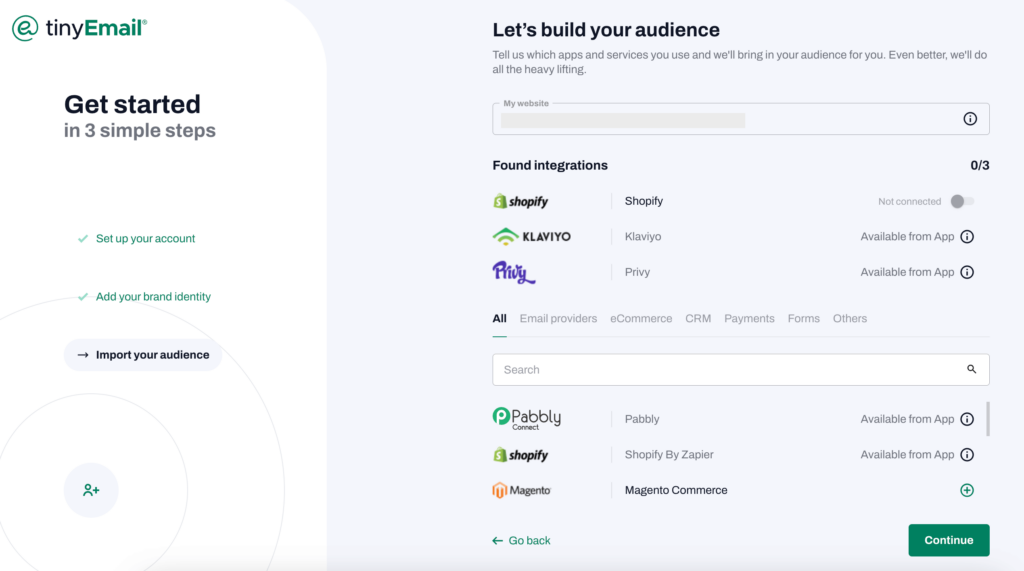
tinyEmail getting started process
For instance, the platform requires you to upload your logo, pick brand colors, and upload your personal and business details to get started. You also have to provide your credit card details during the free trial.
With Constant Contact, you don’t need to provide your credit card information for the free trial. You only pay when you subscribe to a paid plan. More importantly, you’ll get a 30-day money refund guarantee if you’re unsatisfied with the tool for whatever reason.
After completing the signup process, you will discover that the settings section of both tools is well-organized.
Constant Contact’s initial dashboard will help you get started with its straightforward instructions that show you what to do next. This is also the case with tinyEmail, which has an intuitive user experience to guide you through the account setup process.
Constant Contact is the winner here. The platform’s signup process doesn’t require an inordinate amount of personal information.
Building an email campaign
A well-crafted email campaign has a greater chance of capturing your audience’s attention and motivating them to take action.
In this section, we’ll compare tinyEmail and Constant Contact to determine the most effective tool for building efficient email campaigns.
We discovered that both tools are ideal for building email campaigns. tinyEmail has an intuitive email builder with a clear design. Creating email campaigns is a breeze with its wizard’s many customization options.
Constant Contact’s email wizard differs slightly from other email marketing platforms but still offers a simple way to build emails. The wizard has simple navigation and content layouts for organizing the structure of your emails.
To make emails pop, both tools offer an extensive library of images. However, you must be on a paid plan to access Constant Contact’s image library. Free trial users can only use the free images.
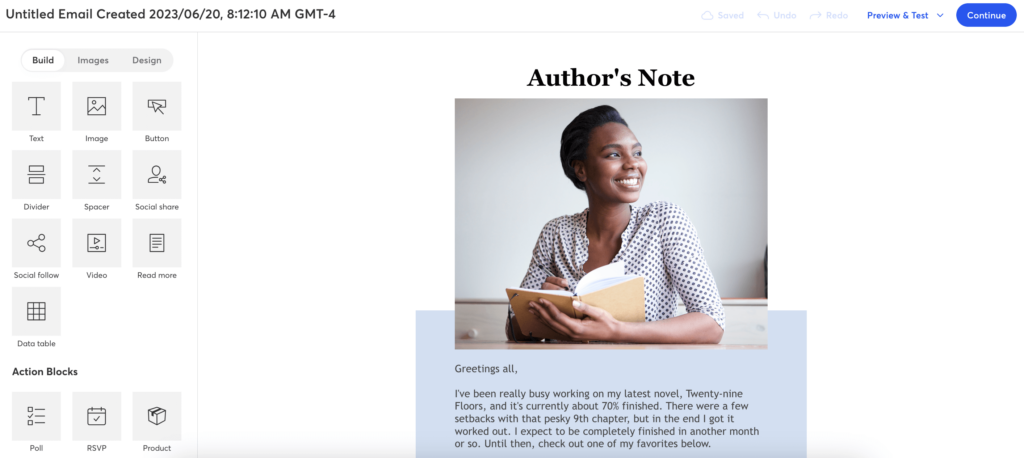
Constant Contact Email editor
Another thing worth considering when assessing the ease of building email campaigns is the availability of email templates. Here’s how these tools compare.
The tinyEmail platform offers a wide selection of 600+ email templates designed for various business cases. Templates are visually appealing, and look decent for nowadays’ email trends.
Constant Contact also offers a wide range of email templates. Many of them are visually appealing and are suitable for different occasions. However, some templates look outdated and boring.
Constant Contact provides a wide variety of campaign selections for users to choose from. The platform allows you to send promotional campaigns and automated emails. You can also run A/B tests to find the most effective campaign subject lines.
In contrast, tinyEmail only allows you to send regular email campaigns. The platform doesn’t support A/B tests at the moment, meaning you’ll have to find alternative ways of testing the effectiveness of your email components.
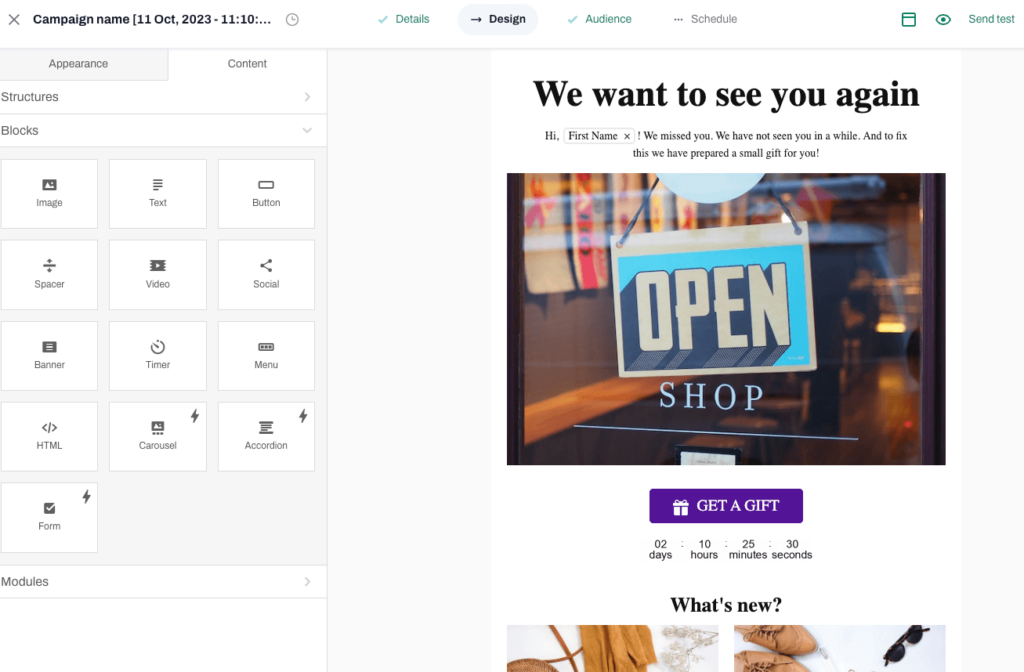
tinyEmail Email editor
Both tools support email personalization but to varying degrees. Personalization with tinyEmail is only available through merge tags. There are no dynamic elements or personalized product recommendations, which is possible with Constant Contact.
Constant Contact lets you add merge tags to the subject lines and email content. You can also use dynamic content to personalize your interactions with subscribers.
Lastly, we also noticed that Constant Contact has a coupon content block where you can add dynamic links.
Constant contact wins this round because it supports many campaign types and offers greater personalization.
Marketing automation
The ability to create automated email sequences is a key consideration when choosing an email marketing platform. This section of the tinyEmail vs Constant Contact comparison assesses the marketing automation capabilities of these tools.
By using Constant Contact’s advanced automated features, you can save time and improve your marketing. It’s easy to understand how to set up processes. The platform also uses standard titles and functions to make starting easy.
Compared to Constant Contact, tinyEmail’s automation is very basic. In addition, the platform offers a few automation workflows, mainly for Shopify users.
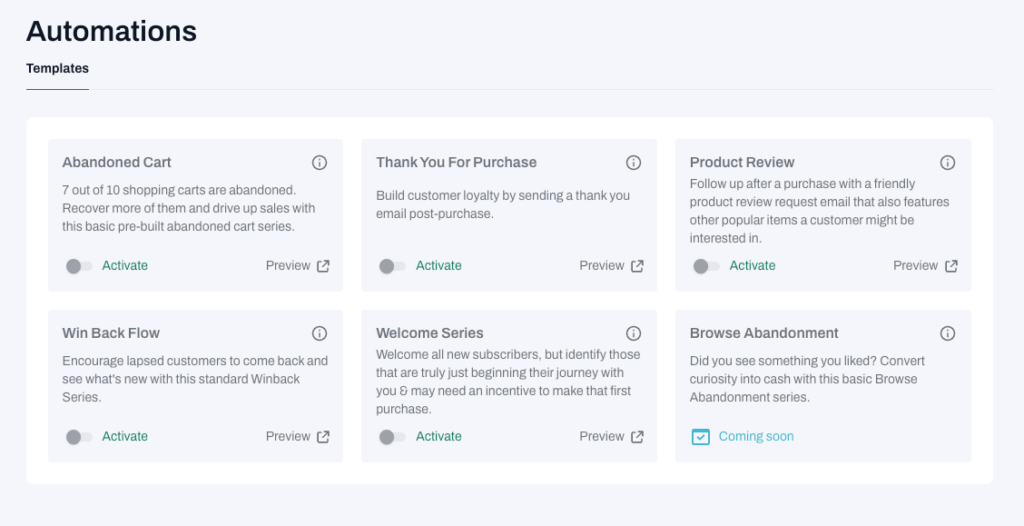
tinyEmail automation
Another letdown with tinyEmail is that you can’t edit the automation logic. You can only activate the automation logic since the platform doesn’t support edits.
Both Constant Contact and tinyEmail offer pre-built workflows to simplify marketing automation. These templates are logic-ready and come with a suggested copy.
When compared to more sophisticated options like ActiveCampaign, Klaviyo, and Omnisend, we also discovered that both platforms’ offerings are limited to the most common business cases, such as:
- Sending automated Welcome series
- Sending an offer
- Sending Thank You messages
- Reactivating dormant subscribers
- Cart recovery
- Product review
- Sending birthday greetings to subscribers
Constant Contact offers increased versatility for those looking to integrate other channels into their workflow seamlessly. For an additional cost, you can include SMS in your operations on Constant Contact.
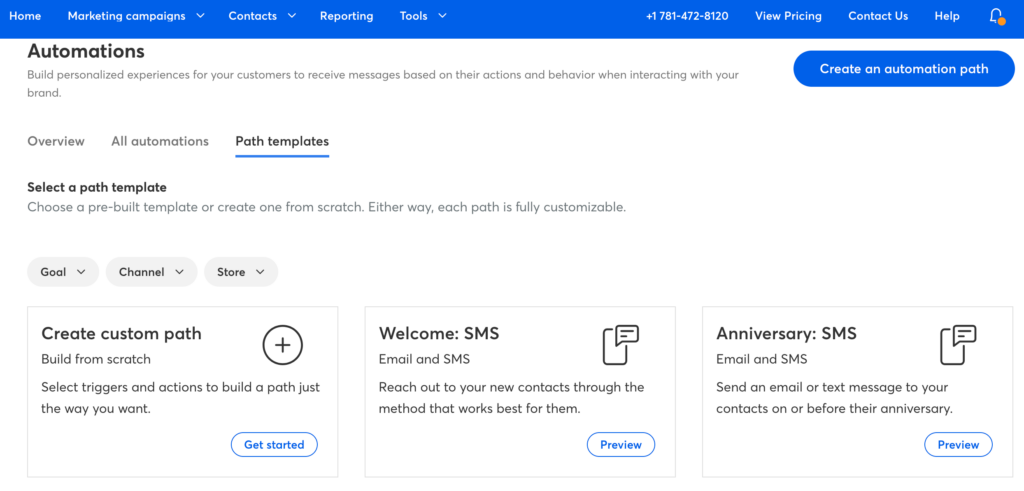
Constant Contact wins this round. The platform offers customizable automation templates and SMS integration.
Signup forms and landing pages
Signup forms and landing pages are crucial to your email marketing strategy. They help you collect and add subscriber details to your mailing list.
In this section, we’ll examine both tools to determine which tools’ signup forms and landing pages outperform the other.
tinyEmail has a library of templates for creating signup forms. The templates are quite versatile, allowing you to develop embedded forms, popups, and flyouts.
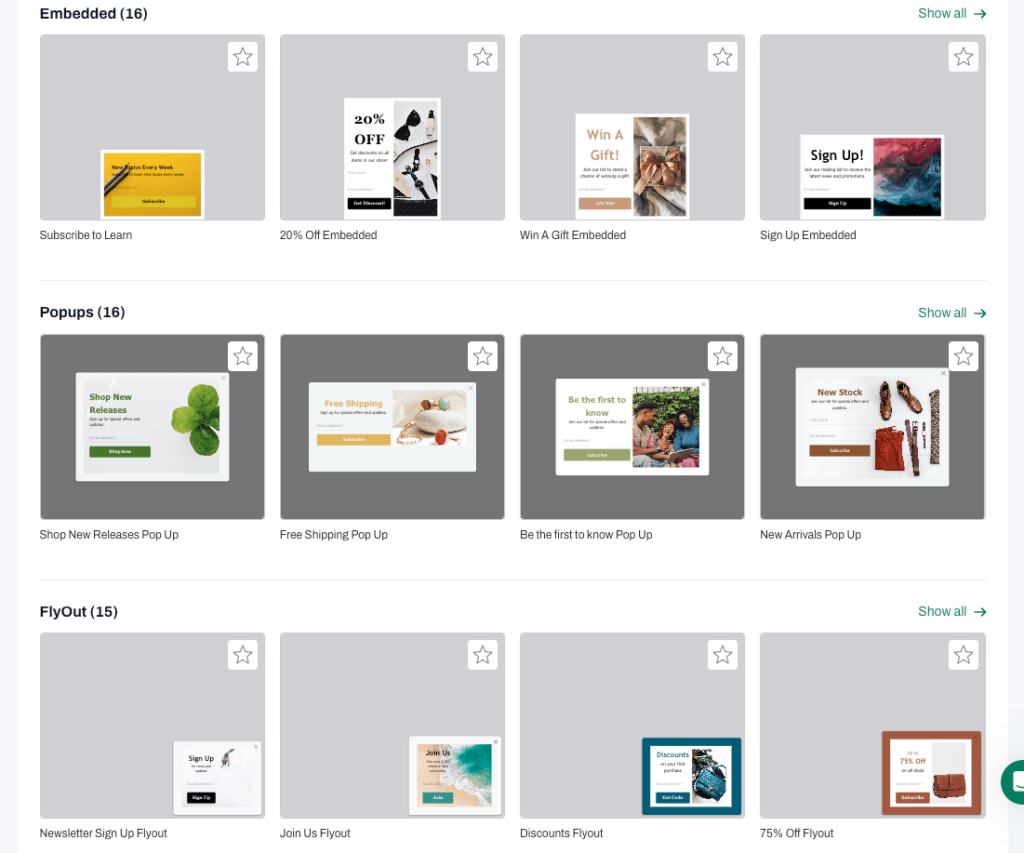
tinyEmail popup library
Constant Contact doesn’t offer any signup form templates. You get one basic form design that you can customize to suit your needs. While both tools have a signup form builder, Constant Contact’s editor is somewhat limited compared to other email marketing platforms.
tinyEmail doesn’t offer signup form analytics to help you gauge the performance of your forms. In contrast, Constant Contact allows you to see the number of submissions, conversion rate, and other signup form metrics.
TinyEmail doesn’t provide landing pages as a feature, so if this is a functionality that you need, your only alternative would be Constant Contact.
That said, Constant Contact doesn’t provide any pre-designed landing page templates. This means you can only build simple landing pages with its basic landing page builder.
After collecting subscriber details, both tools offer straightforward contact management.

tinyEmail is a winner. We liked the signup form variety and designs.
Segmentation
Audience segmentation allows you to engage your audience with relevant content. Examining their segmentation capabilities is important when choosing between Constant Contact and tinyEmail.
First, you’ll notice that both tools have limited segmentation capabilities. Constant Contact only offers four pre-built segments that are based on customer engagement levels, namely:
- Most engaged
- Somewhat engaged
- Least engaged
- Everyone else

Constant Contact Segmentation
These pre-built audience segments are very basic and can only appeal to email marketing beginners. You can create segments yourself. There are some ecommerce, customer behavior filters available. Overall, Constant Contact segmentation isn’t as comprehensive as other advanced email platforms.
tinyEmail doesn’t fare any better. It offers 15 ready-to-use segments based on customer profile information and email engagement activity. There are no ecommerce-oriented, onsite behavior filters or segments based on tags.
Additionally, the segmentation is only available to tinyEmail’s paid plan users. Standard plan users have only been offered four segments. To access all segments, you must be on the Pro plan.
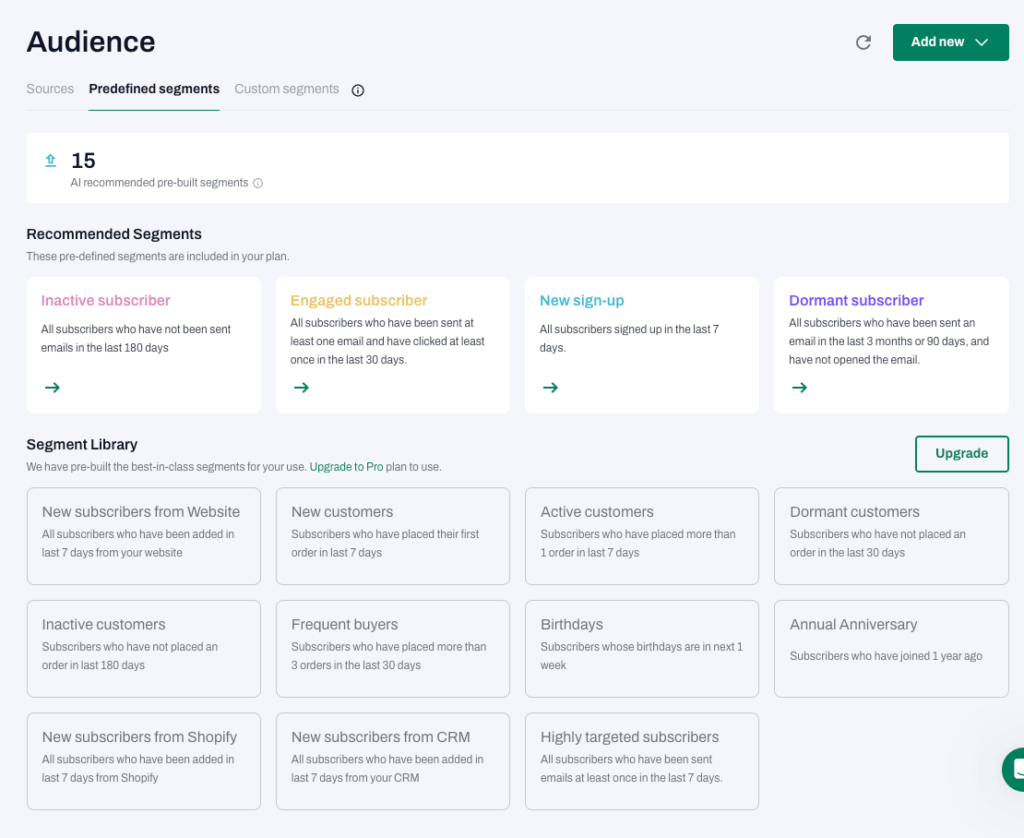
tinyEmail Segmentation library
This round ends in a tie because both tools have limited segmentation options.
Analytics
Analytics is a key component of your email marketing strategy. Insights from the campaign data will help you improve your campaigns and achieve your goals.
Constant Contact tracks and reports on crucial email marketing metrics such as:
- Sends
- Opens
- Clicks
- Bounced emails
- Unsubscribes
- Campaign trends over time
When you run automated campaigns, the tool tracks the following metrics for you:
- Number of subscribers in the workflow
- Revenue generated from the workflow
- Conversions and conversion rate
- Insights from the conditional splits
- Email engagement rates
Constant Contact doesn’t provide ecommerce insights from email campaigns, heatmaps, geolocation reports.
tinyEmail provides campaign analytics but at a basic level. The platform only tracks your campaign performance trend and activity metrics such as opens, clicks, and delivery rate.
You can also see the number of clicks on your email links, but that’s it. There are no geolocation reports, ecommerce insights, and signup form analytics.
The other thing worth noting is that Constant Contact has a mobile app that makes it easy to access campaign analytics.
Constant Contact is the winner in this category because of its better reporting in marketing automation and signup forms.
Customer support
Many customers never use customer support. However, this service can be extremely helpful when you face unexpected challenges or just need some guidance in launching your campaigns.
Here’s how the customer support options offered by Constant Contact vs tinyEmail compare.
tinyEmail offers all users chat and email support 24/7.
Meanwhile, Constant Contact offers support only on working days. On weekends, you’ll have to rely on other online resources for support, such as help center articles.
tinyEmail offers various ways to help you use the platform effectively. Besides onboarding calls for new users, it has a blog, video tutorials, and a help center categorized by topic.
We like that tinyEmail offers support whenever you need them.
Integrations
Integrations allow you to extend the functionality of your email marketing tool. Our analysis revealed that both tools support multiple integrations to amplify your marketing capabilities.
Constant Contact has a robust selection of 300+ integrations. The top integrations include Canva, Salesforce, Eventbrite, and Gmail.
Meanwhile, tinyEmail integrates with CRM platforms like HubSpot, Zoho CRM, and Salesforce to help you manage your audience effectively. It also connects with ecommerce platforms like WooCommerce, Shopify, and Magneto.
This tinyEmail vs Constant Contact comparison ends in a draw. Both tools offer multiple integrations with other tools.
Compatibility with other marketing channels
Email is a robust channel, and combining it with other marketing channels can significantly enhance your overall strategy. When evaluating these tools, it’s crucial to consider their compatibility with other channels if you want to run multi-channel campaigns.
With Constant Contact you can add SMS to your campaigns, but at an extra cost. This feature is only available for US subscribers.
tinyEmail only offers email marketing at the moment. There is a plan to add SMS in the future but we have to wait to see how that works out.
Besides SMS, Constant Contact is compatible with social media platforms to help you connect with your audience on multiple channels. The tool integrates with Instagram, LinkedIn, and Twitter to help you reach your audience where they spend most of their time.
It also allows you to publish Facebook and Google Ads to get your message to as many people as possible.
Constant Contact wins this round because it integrates SMS and social media into the workflow to increase your reach.
Generative AI tools
Finally, let’s explore whether these platforms leverage generative AI to help you create your email content with ease.
tinyEmail features TinyAlbert, a generative AI tool powered by ChatGPT 4. TinyAlbert generates actionable subject lines and email copy to help you with easy email creation.
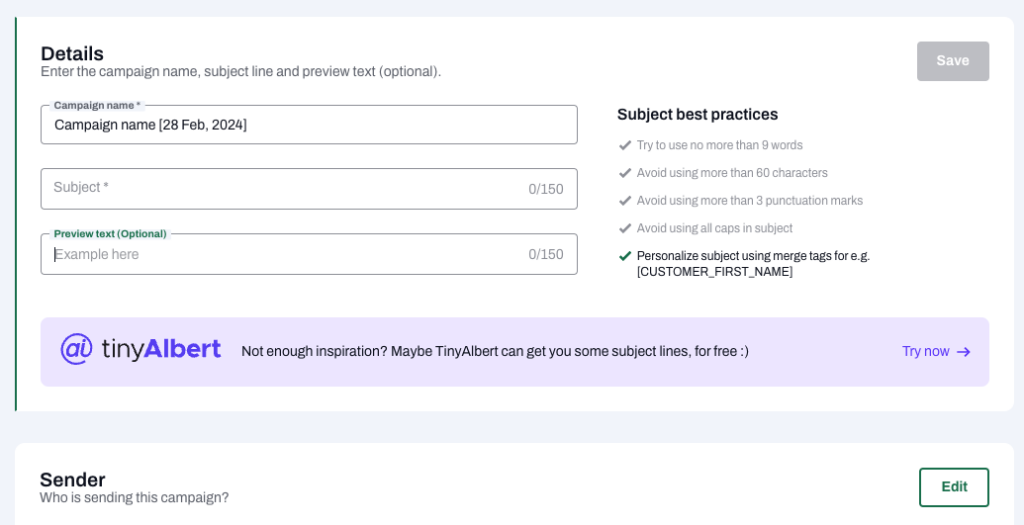
Constant Contact also features an AI content generator capable of creating amazing subject lines and email copy. By providing a few keywords and selecting the message tone, the generator recommends relevant content that aligns with your goals.
It’s a tie again.
Price Comparison
This section compares the pricing structures of Constant Contact and tinyEmail to help you determine which tool fits within your budget.
First, let’s see what you can get for free. Free plans and trials allow you to try the platform and understand better if it’s the right fit for you. Also, for some email beginners it might be an option how to get started with email marketing activities without spending money.
Free plans comparison
Let’s start the Constant Contact vs tinyEmail price comparison by comparing their free plans.
tinyEmail’s free plan caters to the needs of novice marketers. It offers the following features:
- Reach (up to 500 subscribers)
- Signup forms and popups
- Automation emails
- AI subject line assistant: max 15 per day
- Limited sender identities
- Limited templates
- Access to all integrations
- Limited reporting
Constant Contact doesn’t have a free plan, but it offers a 14-day free trial that you can access without providing your credit card details.
However, many features are locked up during the free trial. For example, free trial users can’t publish signup forms or access the automation features. We find this trial to be a very limited one.
Paid plan comparison
Let’s now compare the paid plans to help you determine which platform meets your budget requirements.
As you can see below, the main difference is that Constant Contact’s pricing is based on the number of subscribers and tinyEmail’s–on the number of monthly emails.
Constant Contact has three plans that cater to different needs.
- Lite
- Standard
- Premium
For ecommerce businesses, the Premium plan is the most sufficient because only this plan includes revenue reporting.
In addition to the Free plan, tinyEmail offers three paid plans with a full-featured 7-day trial.
- Standard
- Pro
- Enterprise (custom pricing)
- Shopify Pro (free to Shopify users)
The price for each plan is based on the number of emails you plan to send.
Constant Contact vs tinyEmail: Which one wins?
Before we determine the winner of this Constant Contact vs tinyEmail comparison, let’s go over their key features one last time.
4.0
3.5
500 subscribers – $12
1,000 subscribers – $30
5,000 subscribers – $80
10,000 subscribers – $120
50,000 subscribers – $430
100,000 subscribers – Custom price
Up to 15,000 emails – $15
Up to 25,000 emails – $25
Up to 50,000 emails – $50
Up to 100,000 emails – $100
14-day free trial
- Up to 500 subscribers
- Up to 15,000 emails
- Forms and popups
- Automation emails
- AI subject line assistant
- Limited sender identities
- Shopify Pro plan for Shopify users
- Easy to get started
- Great customer support
- Great compatibility with other marketing channels
- Easy to signup and use
- Good email builder
- An extended list of email templates
- Basic signup forms and landing pages
- Basic reporting
- Basic automation and reporting
- Basic segmentation
- Form builder should be improved
- Reliable customer support
- Generative AI tools, nice templates, easy to use platform
- Ecommerce beginners
- Non-profit organizations
- Small ecommerce businesses and email marketing beginners
- Bloggers
- Non-profit organizations
- Well-established ecommerce businesses
- Lifestyle bloggers
- Established ecommerce business
The table above summarizes our Constant Contact vs tinyEmail comparison. We’ve compared their key features to give you a clear picture of each tool’s capabilities.
Constant Contact’s comprehensive features make it ideal for businesses of all sizes. Meanwhile, tinyEmail stands out as a simple and affordable solution for businesses with basic email marketing needs.
Ultimately, your choice will depend on your needs and budget. Carefully consider your specific requirements and pick a platform that best aligns with your business objectives.
Use this detailed Constant Contact vs tinyEmail review to find the tool with all the features you need to succeed with email marketing.
Related picks for you
Our team strives to be accurate and unbiased in reviewing email tools. However, we recognize that mistakes can happen, and it’s essential for us to stay up to date. If you come across any errors or things that need to be reviewed again, please let us know.


Leave a Reply